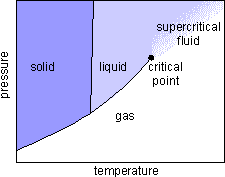| Vocabulary | |
caffeine critical point  critical pressure  critical temperature  dichloromethane  distillation  extraction  recrystallization  reverse osmosis  supercritical fluid  |
Ethyl acetate was used as a replacement for dichloromethane during the 80's and early 90's. Although it too is moderately toxic, coffee makers touted ethyl acetate as "natural" because it was present in fruit.
A nontoxic and more environmentally benign solvent than either dichloromethane or ethyl acetate is now used: supercritical fluid carbon dioxide.
 When a sealed vial containing both gaseous and liquid carbon dioxide under high pressure is heated, the liquid density drops while the gas density rises. If the pressure is above 72.8 atm, and the temperature rises above
304.2 K, the density of the liquid and the density of the gas become identical.
The meniscus between the liquid and gas phases vanishes. The carbon dioxide becomes a supercritical fluid
which has both gaslike and liquidlike properties. The fluid fills the container like a gas, but can dissolve substances like a liquid. Supercritical fluid carbon dioxide is an excellent nonpolar solvent for many organic compounds, including caffeine.
When a sealed vial containing both gaseous and liquid carbon dioxide under high pressure is heated, the liquid density drops while the gas density rises. If the pressure is above 72.8 atm, and the temperature rises above
304.2 K, the density of the liquid and the density of the gas become identical.
The meniscus between the liquid and gas phases vanishes. The carbon dioxide becomes a supercritical fluid
which has both gaslike and liquidlike properties. The fluid fills the container like a gas, but can dissolve substances like a liquid. Supercritical fluid carbon dioxide is an excellent nonpolar solvent for many organic compounds, including caffeine.
The extraction process is simple. Supercritical carbon dioxide is forced through green coffee beans. Its gaslike behavior allows it to penetrate deep into the beans, and it dissolves 97-99% of the caffeine present. The caffeine is valuable, and coffee manufacturers usually try to recover it. The caffeine-laden CO2 is sprayed with high pressure water and caffeine is then isolated by a variety of methods, including charcoal adsorption, distillation, recrystallization, or reverse osmosis.
References
- O'Brien, M.J., Spence, J.E., Skiff, R.H., Vogel, G. J., Prasad, R.: "Caffeine Recovery from Supercritical Carbon Dioxide", US Patent 4.996.317, 1991
Decaffeinating Coffee
(Scientific American) 
A brief article by Saul Katz describes various methods for decaffeinating coffee. The article includes a step-by-step illustration of supercritical fluid carbon dioxide extraction of caffeine.
http://www.sciam.com/0697issue/0697working.html (04/06/99)
Related resources
-
Introduction to Supercritical Fluids
| A brief introduction to supercritical CO2 extraction, an economically important technology used to decaffeinate coffee and tea, extract hops flavors in brewing, and extracting aromas and flavors from spices and herbs. http://www.phasex4scf.com/scf.htm (7/2/99) |
| An introduction to supercritical fluids and their applications, including decaffeination of coffee and waste treatment. http://www.ceic.unsw.edu.au/centers/SF1/scf.htm (04/06/99) |